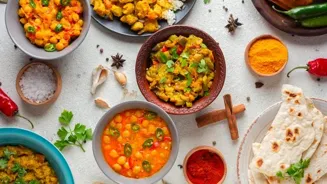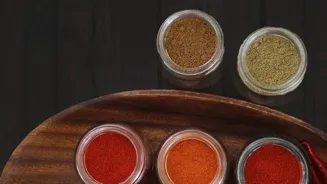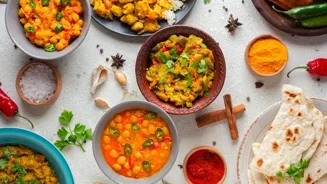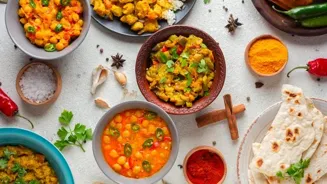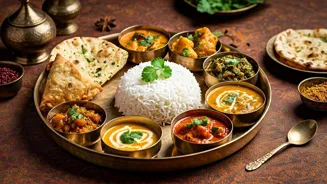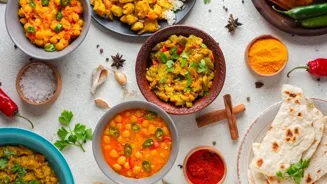Dive into the world of Indian chutneys - from traditional recipes to cultural significance. Uncover the flavors that define Indian cuisine
Chutneys are an integral part of the Indian culinary landscape,
adding a burst of flavour and zest to every meal.
These vibrant condiments, made from a variety of fruits, vegetables, herbs, and spices, are more than just accompaniments; they are a reflection of India's diverse regional cuisines and culinary traditions.
From the sweet and tangy mango chutney to the fiery mint-coriander chutney, each variation offers a unique taste experience that tantalizes the palate. Chutneys can be freshly made or preserved, served with snacks, main courses, or even as a standalone dip.
Their versatility is unparalleled, making them a staple in every Indian household. Come, let's explore this fascinating world of Indian chutneys, discovering their recipes, uses, and the cultural significance they hold.
Indian chutneys enhance dishes with diverse flavors and spices, vital for culinary balance
Indian cuisine is celebrated for its complex flavours and aromatic spices, and chutneys play a crucial role in achieving this culinary balance. These flavourful condiments act as taste enhancers, adding a zing to even the simplest of dishes.
Imagine enjoying a plate of crispy dosas without the cooling touch of coconut chutney or savouring a spicy samosa without the sweet and tangy tamarind chutney. Chutneys not only complement the main course, but also aid digestion, thanks to the herbs and spices used in their preparation.
In many Indian households, preparing chutneys is a cherished tradition, passed down through generations. The recipes often vary from family to family, reflecting personal preferences and regional influences.
The sheer variety of chutneys available across India is astounding, each region boasting its own unique specialties.
Explore popular Indian chutney recipes like Coconut and Mint-Coriander Chutney
Now, let's delve into some popular Indian chutney recipes that you can easily make at home and give a try to them and savor the tangy taste. One of the most beloved is the classic Coconut Chutney, a staple in South Indian cuisine.
To prepare this, you'll need freshly grated coconut, green chilies, ginger, and roasted chana dal (split chickpeas). Grind these ingredients together with water until you achieve a smooth consistency. Temper the chutney with mustard seeds, curry leaves, and a pinch of asafoetida in hot oil.
This chutney pairs perfectly with dosas, idlis, vadas, and uttapams. Moving towards the North, we have the ever-popular Mint-Coriander Chutney, also known as Hara Chutney.
This refreshing chutney is made with fresh mint leaves, coriander leaves, green chilies, ginger, garlic, and a squeeze of lemon juice. Simply blend all the ingredients together until smooth, adding water as needed.
This chutney is a fantastic accompaniment to samosas, pakoras, sandwiches, and tikkas.
Tomato and Mango Chutney recipes with sweet, tangy flavors
Another delightful chutney is the Tomato Chutney, a versatile condiment that adds a tangy and slightly sweet flavour to any dish. To make this, you'll need ripe tomatoes, onions, garlic, ginger, green chilies, and a blend of spices like cumin, coriander, and turmeric.
Sauté the onions, garlic, and ginger in oil until golden brown, then add the chopped tomatoes and spices. Cook until the tomatoes are softened and the mixture thickens. Let it cool, then blend till you achieve a smooth chutney.
This chutney can be enjoyed with rice, roti, parathas, or as a dip for snacks. For those who enjoy a sweeter chutney, the Mango Chutney is an excellent choice. Made from raw or semi-ripe mangoes, this chutney is a balance of sweet, tangy, and spicy flavours.
Grate the mangoes and cook them with sugar, vinegar, ginger, garlic, and a blend of spices like chili powder, cumin, and mustard seeds. Simmer until the mangoes are softened and the chutney thickens.
Chutneys add flavor to dishes, spreads for sandwiches, marinades, dressings, and dips
Chutneys are incredibly versatile and can be used in a variety of ways to enhance the flavour of your meals. Besides serving them as accompaniments to traditional Indian dishes, you can use them as spreads for sandwiches and wraps of your choice.
Mint-coriander chutney makes a refreshing addition to a veggie sandwich, while tomato chutney adds a tangy kick to a chicken or paneer wrap. Chutneys can also be used as marinades for grilling or baking.
Marinating paneer or chicken in a mixture of yogurt and your favorite chutney before grilling infuses the meat with flavour and keeps it moist. Moreover, chutneys are excellent as salad dressings.
Thin out your chosen chutney with a little water or vinegar and drizzle it over your salad for an extra burst of flavour. And finally, use can consider to use chutneys as dips for everything from vegetable sticks to chips.
Indian chutneys embody culture, tradition, and celebration in culinary heritage
Beyond the delicious flavours and exciting recipes, Indian chutneys hold a special place in Indian culture. They represent the ingenuity and resourcefulness of Indian cooks who have found ways to preserve seasonal produce and create flavourful condiments using simple ingredients.
The act of making chutney is often a communal activity, with family members coming together to chop vegetables, grind spices, and share stories. Chutneys are also an integral part of festive meals, adding a touch of celebration and joy to the occasion.
Whether it's a simple family dinner or a grand feast, chutneys are always present, adding that extra zing to every bite, completing the Indian food. So, go ahead, experiment with different chutney recipes, and discover your own favourite flavour combinations.
And most importantly, savor the rich culinary heritage that these humble condiments represent.
AI Generated Content. Glance/InMobi shall have no liability for the content